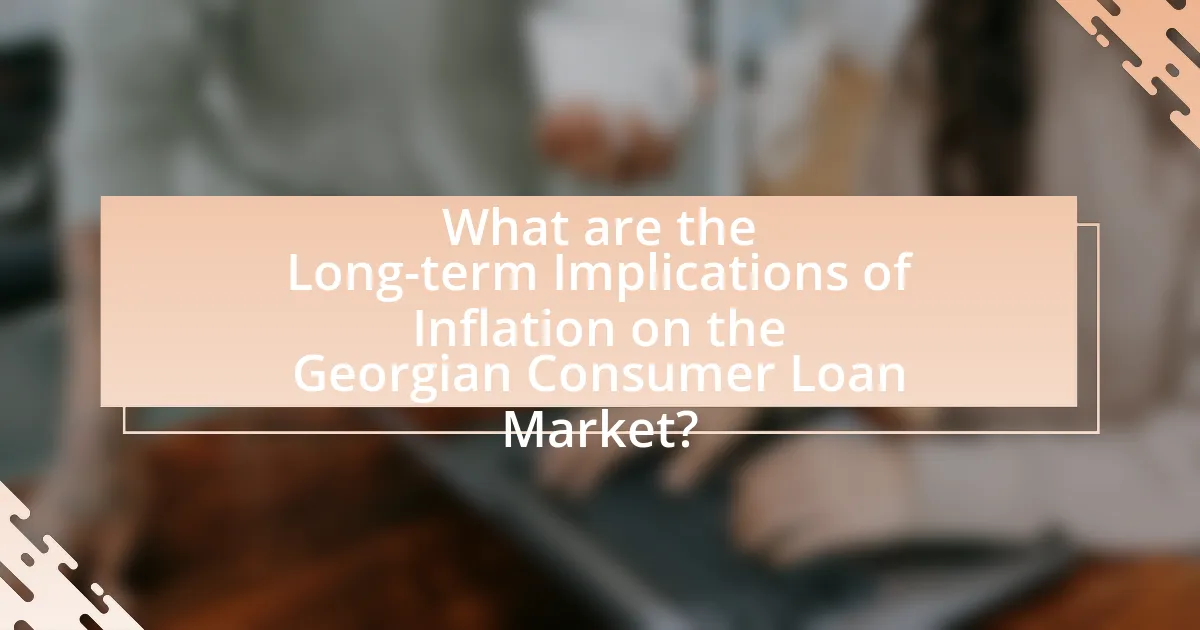The article analyzes the effects of inflation on consumer loans in Georgia, highlighting how rising inflation increases borrowing costs and diminishes purchasing power for consumers. It discusses the relationship between inflation, interest rates, and loan repayment capabilities, emphasizing the financial strain on borrowers as monthly payments rise. Key economic indicators such as the Consumer Price Index (CPI) and interest rates are examined for their relevance in understanding these dynamics. Additionally, the article outlines the specific challenges faced by Georgian consumers due to inflation, including increased default rates and the implications for the consumer loan market. Strategies for consumers to mitigate the impact of inflation on loans are also presented, providing insights into effective financial planning during inflationary periods.

What are the Effects of Inflation on Georgian Consumer Loans?
Inflation negatively impacts Georgian consumer loans by increasing the cost of borrowing and reducing the purchasing power of consumers. As inflation rises, interest rates typically increase, leading to higher monthly payments for borrowers. For instance, in Georgia, the National Bank has raised its policy rate to combat inflation, which directly affects the interest rates on consumer loans. Consequently, borrowers face greater financial strain as their loan repayments become more expensive, while their real income diminishes due to the eroding value of money. This dynamic can lead to increased default rates on loans, as consumers struggle to meet their financial obligations amidst rising costs.
How does inflation impact the cost of borrowing for consumers in Georgia?
Inflation increases the cost of borrowing for consumers in Georgia by raising interest rates. When inflation rises, lenders typically respond by increasing interest rates to maintain their profit margins and offset the decreased purchasing power of money. For instance, if inflation in Georgia reaches 5%, lenders may raise interest rates on loans to ensure that the returns on their loans remain attractive compared to the eroding value of money. This dynamic results in higher monthly payments for consumers and can limit their borrowing capacity, as the overall cost of loans becomes more expensive.
What are the direct effects of rising interest rates on consumer loans?
Rising interest rates directly increase the cost of consumer loans, leading to higher monthly payments for borrowers. As interest rates rise, lenders adjust their rates to reflect the increased cost of borrowing, which can result in a decrease in loan affordability for consumers. For example, a 1% increase in interest rates can raise monthly payments on a $20,000 loan by approximately $20 to $30, depending on the loan term. This increase can discourage consumers from taking out loans or lead to higher default rates as borrowers struggle to meet their payment obligations. Additionally, higher interest rates can reduce overall consumer spending, as individuals allocate more of their budgets to servicing debt rather than making new purchases.
How does inflation influence consumer purchasing power in Georgia?
Inflation decreases consumer purchasing power in Georgia by increasing the prices of goods and services, which means consumers can buy less with the same amount of money. For instance, if the inflation rate in Georgia rises to 10%, the cost of living increases, leading to higher prices for essentials like food and housing. Consequently, consumers find that their income does not stretch as far as it once did, effectively reducing their ability to make purchases. This relationship is evident in economic data, which shows that as inflation rates climb, real wages often fail to keep pace, further eroding purchasing power.
What role do economic indicators play in understanding inflation’s effects?
Economic indicators are crucial for understanding inflation’s effects as they provide measurable data that reflects the economic environment. Key indicators such as the Consumer Price Index (CPI), Producer Price Index (PPI), and unemployment rates help gauge inflation trends and their impact on purchasing power. For instance, a rising CPI indicates increasing prices, which can erode consumer purchasing power and affect loan repayment capabilities. Historical data shows that during periods of high inflation, such as in the 1970s, consumer behavior shifted significantly, leading to increased default rates on loans. This correlation underscores the importance of monitoring economic indicators to assess inflation’s impact on consumer loans in Georgia.
Which economic indicators are most relevant to inflation and consumer loans?
The most relevant economic indicators to inflation and consumer loans are the Consumer Price Index (CPI), interest rates, and unemployment rates. The Consumer Price Index measures the average change over time in the prices paid by consumers for goods and services, directly reflecting inflation levels. Interest rates, set by central banks, influence borrowing costs for consumer loans; higher rates typically lead to reduced loan demand as borrowing becomes more expensive. Unemployment rates indicate the overall economic health and consumer purchasing power, affecting loan repayment capabilities. Historical data shows that in periods of rising CPI, central banks often increase interest rates to combat inflation, which can lead to a decrease in consumer loan activity.
How do these indicators correlate with consumer loan trends in Georgia?
Inflation indicators in Georgia, such as the Consumer Price Index (CPI) and interest rates, correlate directly with consumer loan trends by influencing borrowing costs and consumer purchasing power. As inflation rises, the CPI typically increases, leading to higher interest rates set by financial institutions to mitigate risk. For instance, when the CPI in Georgia increased by 5% in 2022, banks responded by raising interest rates on consumer loans, which subsequently led to a decline in loan applications as consumers faced higher repayment costs. This relationship illustrates how inflationary pressures can dampen consumer borrowing activity, as evidenced by a reported 15% decrease in new consumer loans issued during that period.
Why is it important to analyze inflation’s effects on consumer loans?
Analyzing inflation’s effects on consumer loans is crucial because it directly impacts borrowing costs and consumer purchasing power. When inflation rises, interest rates typically increase, leading to higher loan repayments for consumers. For instance, in Georgia, a 1% increase in inflation can result in a corresponding rise in interest rates, making loans more expensive and potentially reducing consumer spending. Understanding these dynamics helps lenders and policymakers make informed decisions, ensuring financial stability and protecting consumers from excessive debt burdens.
What are the potential risks for consumers facing high inflation rates?
High inflation rates pose several risks for consumers, primarily through eroding purchasing power and increasing the cost of living. As prices rise, consumers find that their income buys fewer goods and services, leading to potential financial strain. For instance, in Georgia, a 2022 report indicated that inflation reached 12.8%, significantly impacting household budgets and forcing consumers to prioritize essential expenses over discretionary spending. Additionally, high inflation can lead to increased interest rates on loans, making borrowing more expensive and potentially leading to higher default rates among consumers unable to meet their financial obligations. This scenario creates a cycle where consumers face both immediate financial pressure and long-term economic instability.
How can understanding these effects help consumers make informed decisions?
Understanding the effects of inflation on consumer loans enables Georgian consumers to make informed financial decisions by allowing them to anticipate changes in interest rates and loan repayment costs. When consumers recognize that inflation can lead to higher interest rates, they can evaluate the timing of loan applications, potentially opting for fixed-rate loans to lock in lower rates before they rise. Additionally, awareness of inflation’s impact on purchasing power helps consumers assess the real cost of borrowing, ensuring they choose loans that align with their financial capabilities. For instance, a study by the National Bank of Georgia indicates that inflation directly influences lending rates, which underscores the importance of understanding these economic effects for better financial planning.

What are the Specific Challenges Faced by Georgian Consumers Due to Inflation?
Georgian consumers face several specific challenges due to inflation, primarily characterized by rising prices, decreased purchasing power, and increased cost of living. As inflation rates in Georgia have surged, essential goods and services have become more expensive, leading to financial strain on households. For instance, the National Statistics Office of Georgia reported a year-on-year inflation rate of approximately 12.5% in 2022, significantly impacting food and energy prices. This inflationary pressure forces consumers to allocate a larger portion of their income to basic necessities, leaving less for savings or discretionary spending. Additionally, the increased cost of borrowing, as interest rates rise in response to inflation, further complicates the financial landscape for consumers seeking loans, making it more difficult to manage existing debts or finance new purchases.
How does inflation affect loan repayment capabilities for consumers?
Inflation negatively impacts loan repayment capabilities for consumers by eroding purchasing power and increasing the cost of living. As inflation rises, the real value of money decreases, meaning consumers need more income to maintain their standard of living. For instance, if inflation is at 5% and wages do not increase correspondingly, consumers may struggle to meet their loan obligations due to higher prices for essential goods and services. Additionally, if interest rates rise in response to inflation, the cost of borrowing increases, further straining consumers’ financial situations. Historical data shows that during periods of high inflation, such as the 1970s in the United States, many consumers faced difficulties in repaying loans due to these compounded financial pressures.
What are the implications of increased monthly payments on household budgets?
Increased monthly payments significantly strain household budgets by reducing disposable income available for other expenses. As monthly obligations rise, families may need to cut back on discretionary spending, impacting areas such as dining, entertainment, and savings. According to a report by the Federal Reserve, households with higher debt-to-income ratios often face financial stress, leading to increased reliance on credit and potential long-term financial instability. This trend is particularly relevant in the context of inflation, where rising costs further exacerbate the burden of higher monthly payments, forcing households to prioritize essential expenses over non-essential ones.
How do inflationary pressures lead to defaults on consumer loans?
Inflationary pressures lead to defaults on consumer loans by increasing the cost of living, which reduces disposable income for borrowers. As prices rise, consumers face higher expenses for essentials such as food, housing, and transportation, leaving less money available to meet loan obligations. For instance, in Georgia, a significant rise in inflation rates, which reached over 10% in recent years, has strained household budgets, resulting in increased default rates on loans. This correlation is evident in data showing that as inflation escalates, the percentage of consumers unable to make timely loan payments also rises, highlighting the direct impact of inflation on loan defaults.
What strategies can consumers employ to mitigate the effects of inflation on loans?
Consumers can mitigate the effects of inflation on loans by opting for fixed-rate loans instead of variable-rate loans. Fixed-rate loans maintain the same interest rate throughout the loan term, protecting consumers from rising interest rates that often accompany inflation. Additionally, consumers can consider refinancing existing loans to lock in lower rates before further inflation occurs. According to the Federal Reserve, fixed-rate mortgages have historically provided stability during inflationary periods, as they prevent payment increases that would arise from fluctuating rates. Furthermore, consumers can prioritize paying down high-interest debt, which reduces overall financial burden and exposure to inflationary pressures.
How can consumers adjust their financial planning in response to inflation?
Consumers can adjust their financial planning in response to inflation by revising their budgets to account for rising costs and prioritizing essential expenses. This adjustment involves tracking spending patterns, reducing discretionary spending, and reallocating funds towards necessities such as food, housing, and transportation, which are typically more affected by inflation. According to the Bureau of Labor Statistics, consumer prices in the U.S. rose by 5.4% in 2021, indicating that inflation can significantly impact purchasing power. By increasing savings rates and considering investments that typically outpace inflation, such as stocks or real estate, consumers can better protect their financial health against inflationary pressures.
What role does refinancing play in managing loan costs during inflationary periods?
Refinancing plays a crucial role in managing loan costs during inflationary periods by allowing borrowers to replace existing loans with new ones that have lower interest rates. This is particularly beneficial when inflation leads to rising interest rates, as refinancing can lock in lower rates before they increase further. For instance, during the inflationary period of the late 1970s, many homeowners refinanced to secure fixed-rate mortgages, which helped them mitigate the impact of escalating costs. By reducing monthly payments and overall interest expenses, refinancing can provide financial relief and improve cash flow for borrowers facing inflationary pressures.

What are the Long-term Implications of Inflation on the Georgian Consumer Loan Market?
Long-term implications of inflation on the Georgian consumer loan market include increased borrowing costs and reduced consumer purchasing power. As inflation rises, interest rates typically increase, leading to higher loan repayments for consumers. For instance, the National Bank of Georgia has raised its policy rate in response to inflationary pressures, which directly affects the interest rates on consumer loans. Additionally, prolonged inflation erodes the real value of income, making it more challenging for consumers to meet their loan obligations. This dynamic can lead to higher default rates and a contraction in the overall consumer loan market, as lenders may tighten credit availability in response to increased risk.
How does sustained inflation influence lending practices in Georgia?
Sustained inflation in Georgia leads to tighter lending practices as financial institutions become more cautious about credit risk. When inflation persists, the purchasing power of consumers declines, increasing the likelihood of defaults on loans. Consequently, lenders may raise interest rates to compensate for the increased risk, making borrowing more expensive. For instance, data from the National Bank of Georgia indicates that during periods of high inflation, the average interest rates on consumer loans have risen significantly, reflecting lenders’ need to mitigate potential losses. This trend results in reduced access to credit for consumers, as banks prioritize lending to lower-risk borrowers.
What changes can be expected in interest rates and loan terms?
Interest rates in Georgia are expected to rise due to ongoing inflationary pressures, which typically lead central banks to increase rates to control inflation. As inflation in Georgia reached approximately 10% in recent months, the National Bank of Georgia has responded by raising its benchmark interest rate to 11%, influencing the cost of borrowing. Consequently, loan terms may also tighten, with lenders likely imposing stricter conditions and higher fees to mitigate risk associated with inflation. Historical trends indicate that during periods of high inflation, such as in the early 2000s, similar patterns were observed, where interest rates increased significantly, impacting consumer loans and borrowing costs.
How might inflation reshape the competitive landscape among lenders?
Inflation may reshape the competitive landscape among lenders by increasing interest rates, which can lead to higher borrowing costs for consumers. As inflation rises, lenders often adjust their rates to maintain profit margins, making loans more expensive. This shift can drive consumers to seek out lenders offering more competitive rates or alternative financing options, thereby intensifying competition among financial institutions. Historical data shows that during periods of high inflation, such as the late 1970s and early 1980s, lenders faced significant pressure to adapt their pricing strategies to attract borrowers, illustrating how inflation directly influences lender competitiveness.
What are the best practices for consumers to navigate inflation in the loan market?
Consumers can navigate inflation in the loan market by prioritizing fixed-rate loans over variable-rate loans. Fixed-rate loans provide stability in monthly payments, protecting consumers from rising interest rates that typically accompany inflation. According to the Federal Reserve, during periods of inflation, variable rates can increase significantly, leading to higher overall loan costs. Additionally, consumers should consider refinancing existing loans to lock in lower rates before further inflation occurs, as historical data shows that refinancing can save borrowers substantial amounts in interest payments. Lastly, maintaining a strong credit score enables consumers to qualify for better loan terms, which is crucial in an inflationary environment where lenders may tighten credit standards.
What tips can help consumers secure favorable loan terms during inflationary times?
To secure favorable loan terms during inflationary times, consumers should focus on improving their credit score, shopping around for the best rates, and considering fixed-rate loans. A higher credit score can lead to lower interest rates, as lenders view borrowers with strong credit histories as less risky. According to Experian, a credit score above 700 typically qualifies for better loan terms. Additionally, comparing offers from multiple lenders can help consumers find competitive rates, as rates can vary significantly. Lastly, opting for fixed-rate loans can protect borrowers from rising interest rates, ensuring predictable payments despite inflation.
How can consumers stay informed about economic changes affecting their loans?
Consumers can stay informed about economic changes affecting their loans by regularly monitoring financial news, subscribing to economic reports, and utilizing online resources from financial institutions. Financial news outlets provide updates on interest rates and inflation trends, which directly impact loan conditions. Economic reports from government agencies, such as the National Bank of Georgia, offer insights into monetary policy changes and economic forecasts. Additionally, many banks and credit unions provide newsletters or alerts that inform customers about changes in loan terms or rates, ensuring that consumers are aware of factors that could influence their borrowing costs.